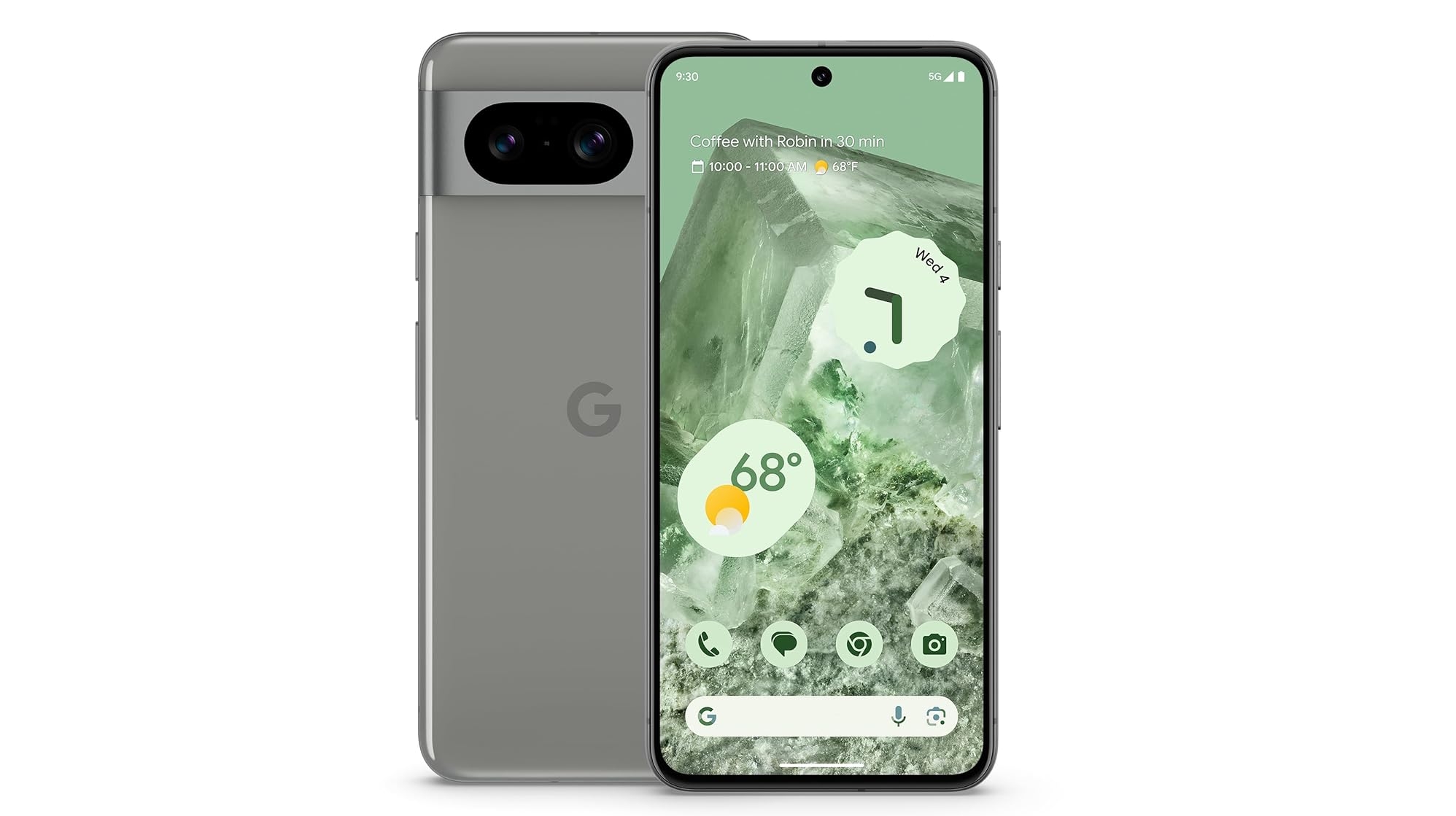
Weight: 187g
Dimensions: 150.5 x 70.8 x 8.9mm
Screen size: 6.2-inch
Resolution: 1080 x 2400
CPU: Tensor G3
RAM: 8GB
Storage: 128GB/256GB
Battery: 4,575mAh
Rear camera: 50MP+12MP
Front camera: 10.5MP
The Google Pixel 8 has most of the core features of the Pixel 8 Pro, including AI tricks, a 50MP main camera, a Tensor G3 chipset, and a 120Hz screen. But it lacks a telephoto camera, and its screen and battery also aren't quite a match for Google's top phone.
For
- New Tensor chip
- Refreshed design
- AI camera tricks
Against
- Design changes are minor
- Minimal camera upgrades
- No temperature sensor
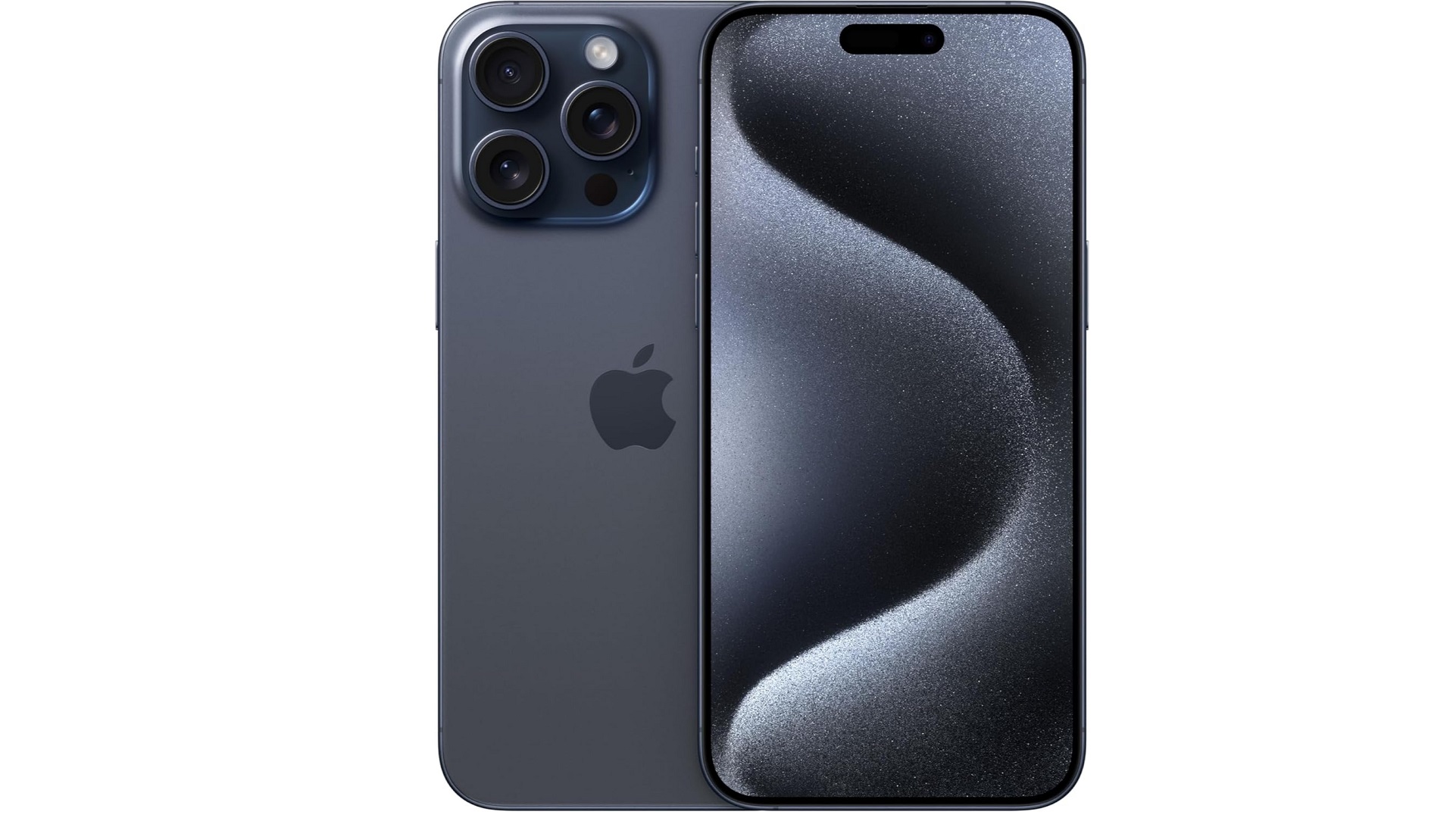
Weight: 221g
Dimensions: 159.9 x 76.7 x 8.3mm
Screen size: 6.7-inch
Resolution: 1290 x 2796
CPU: A17 Pro
RAM: 8GB
Storage: 256GB/512GB/1TB
Battery: 4,441mAh
Rear camera: 48MP+12MP+12MP
Front camera: 12MP
The iPhone 15 Pro Max is Apple's top smartphone. It's only a small upgrade on the iPhone 15 Pro, but if battery life or cameras are priorities for you this is the phone to go for.
For
- Gorgeous design
- Excellent photography
- Cutting-edge performance
Against
- High starting price
- Charging should be faster
- Still not the best zoom
The Google Pixel 8 and the iPhone 15 Pro Max aren’t, perhaps, two phones that you’d naturally compare.
One is the latest compact phone from the maker of Android, while the other is the latest super-sized flagship from the maker of iOS. Aside from a shared release window, they don’t appear to have a lot in common.
It’s an interesting case study, however, in how much of that premium flagship experience you can expect to retain if you want to pay a lot less money and shrink the package into a more manageable form factor.
Given what the Pixel 8 has to offer, then, does the iPhone 15 Pro Max simply represent too much of everything? Well find out in our Google Pixel 8 vs iPhone 15 Pro Max showdown.
Google Pixel 8 vs iPhone 15 Pro Max: specs comparison
Before we get to an in-depth breakdown of how these two phones compare, here’s a brief overview of their key specs.
| Google Pixel 8 | iPhone 15 Pro Max | |
|---|---|---|
| Dimensions: | 150.5 x 70.8 x 8.9mm | 159.9mm x 76.7mm x 8.25mm |
| Weight: | 187g | 221g |
| Display: | 6.2-inch 20:9 adaptive 60Hz to 120Hz 'Actua' OLED | 6.7-inch 'ProMotion Super Retina XDR' OLED |
| Resolution: | 1080 x 2400 | 1290 x 2796 |
| Refresh rate: | Adaptive 60Hz to 120Hz | Adaptive 1Hz to 120Hz |
| Chipset: | Google Tensor G3 | A17 Pro |
| RAM: | 8GB (LPDDR5X) | 8GB |
| Storage: | 128GB, 256GB (UFS 3.1) | 256GB, 512GB, 1TB |
| Rear cameras: | 50MP wide, 12MP ultra-wide | 48MP wide, 12MP ultra-wide, 12MP 5x telephoto |
| Front camera: | 10.5MP | 12MP |
| Battery: | 4,575mAh | 4,441mAh |
| Charging: | 27W wired, 18W wireless (2nd-gen Pixel Stand), 12W wireless (Qi) | 27W wired, 15W wireless (MagSafe), 7.5W wireless (Qi) |
| Colors: | Obsidian, Hazel, Rose | Black Titanium, White Titanium, Blue Titanium, Natural Titanium |
Google Pixel 8 vs iPhone 15 Pro Max: price and availability
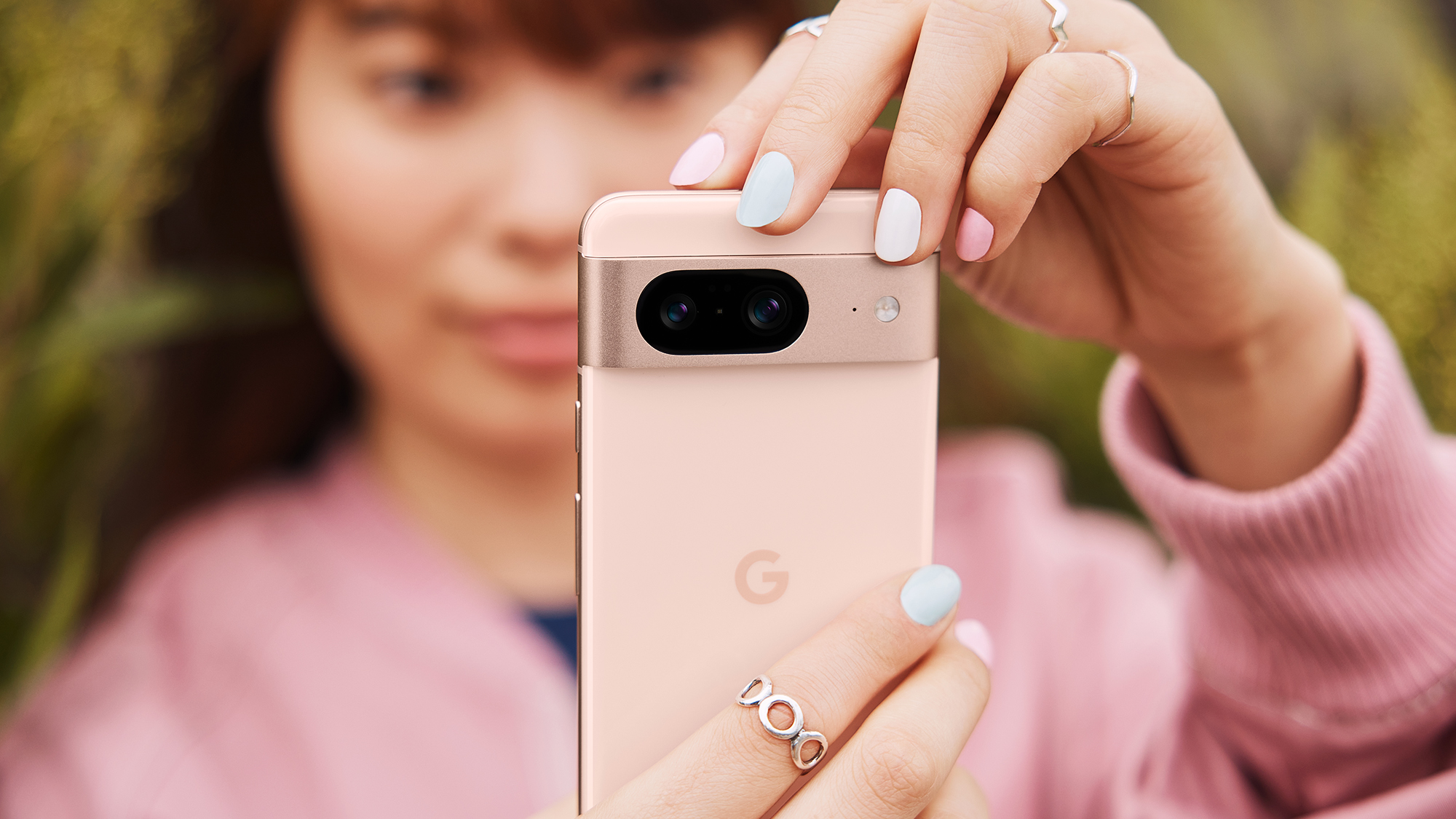
The Pixel 8 and the iPhone 15 Pro launched within a month of one another in late 2023. First up was the iPhone on September 12, with the Pixel 8 following on October 4.
Pricing for the Google Pixel 8 starts from $699 / £699 / AU$1,199 for the 128GB model, while $759 / £759 / AU$1,299 gets you 256GB.
The iPhone 15 Pro Max is considerably more expensive, starting out with the 256GB model at $1,199.99 / £1,199 / AU$2,199. You can double that storage to 512GB for $1,399.99 / £1,399 / AU$2,549, while the top 1TB model costs $1,599.99 / £1,599 / AU$2,899.
Even comparing the like-for-like 256GB models, then, there’s a huge $451 / £440 / AU$900 difference between these two phones.
Google Pixel 8 vs iPhone 15 Pro Max: design and display
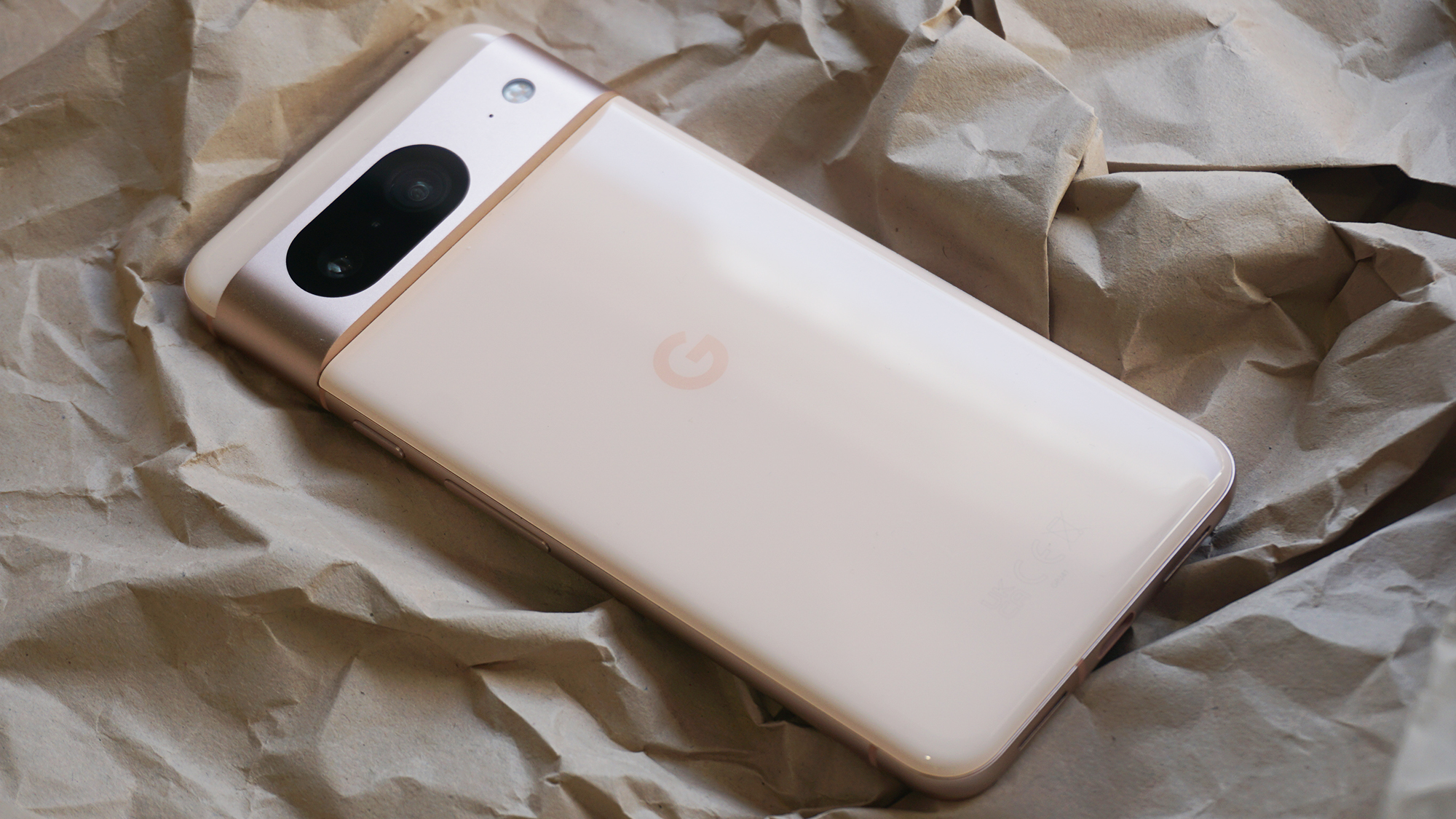
It’s fair to say that Google and Apple have borrowed liberally from one another as Android and iOS have developed as competing mobile platforms over the years. What’s heartening to see, however, is that their phones now look completely different.
Curves are very much the name of the game with the Google Pixel 8, from its bulging rim to the rounded glass rear. Even the camera module swoops and melts into the side of the phone.
Conversely, the iPhone 15 Pro Max is mostly flat surfaces, with a a flat rear and predominantly flat sides. The corners have been rounded off a smidgen in this year’s model, though, which indicates that Apple might be moving towards a more curvaceous design language itself.
We prefer the matte finish of the iPhone’s rear glass panel to the Pixel 8’s shinier approach, though neither sports the most exciting of color options.
There’s a fundamental difference in the makeup of the frames of these two phones too. While the Pixel 8 uses aluminum, the iPhone 15 Pro Max brings in titanium, which is far stronger and more premium.
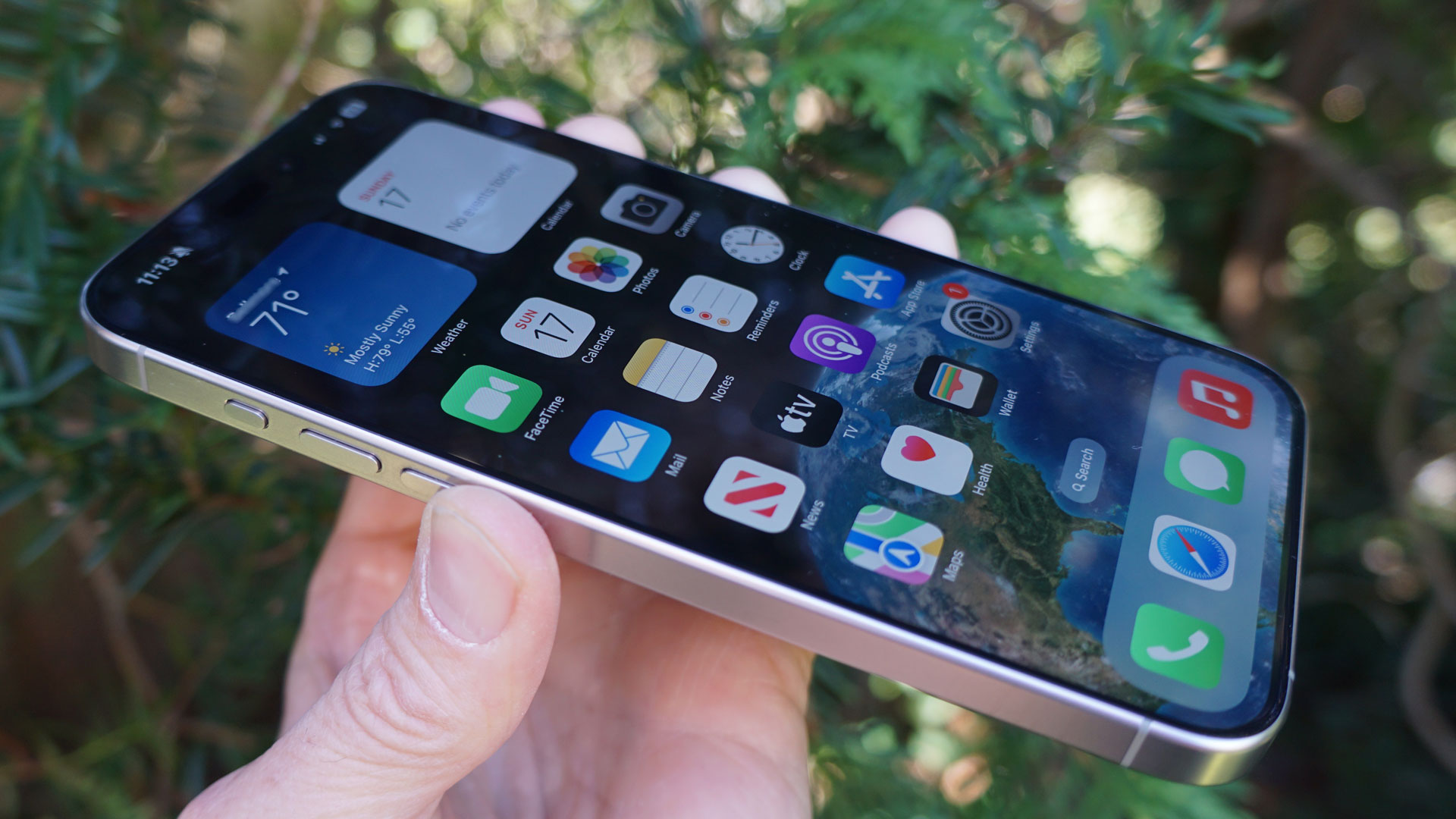
Apple has also added a new Action Button to the left edge of the iPhone 15 Pro Max, which grants a useful customisable app shortcut. It’s the kind of feature you might have expected an Android manufacturer to implement, but curiously few have over the years.
The biggest difference here is one of size. The iPhone 15 Pro Max towers over the Pixel 8 by almost a centimetre, while it’s just over half-a-centimetre wider. It might be a fraction thinner than the Google phone, but it’s also 34g heavier.
Despite being much bigger, the iPhone 15 Pro Max’s screen bezels are thinner and more uniform than the Pixel 8’s, which gives it a sleeker look from the front. Conversely, the iPhone’s Dynamic Island is far more obtrusive than the Pixel 8’s hole punch notch – though it’s also more functional, with a better facial recognition system and a neat heads-up UI.
That fundamental size difference is reflected in the size of the displays. The Pixel 8’s AMOLED display comes in at 6.2 inches, while the iPhone 15 Pro Max’s screen measures 6.7 inches.
This size difference makes comparing screen resolutions somewhat pointless, so we’ll use the pixel density metric instead. At 460 ppi, the iPhone has a slight sharpness advantage over the 428 ppi Pixel, though that size difference arguably negates any hint of a perceivable difference.
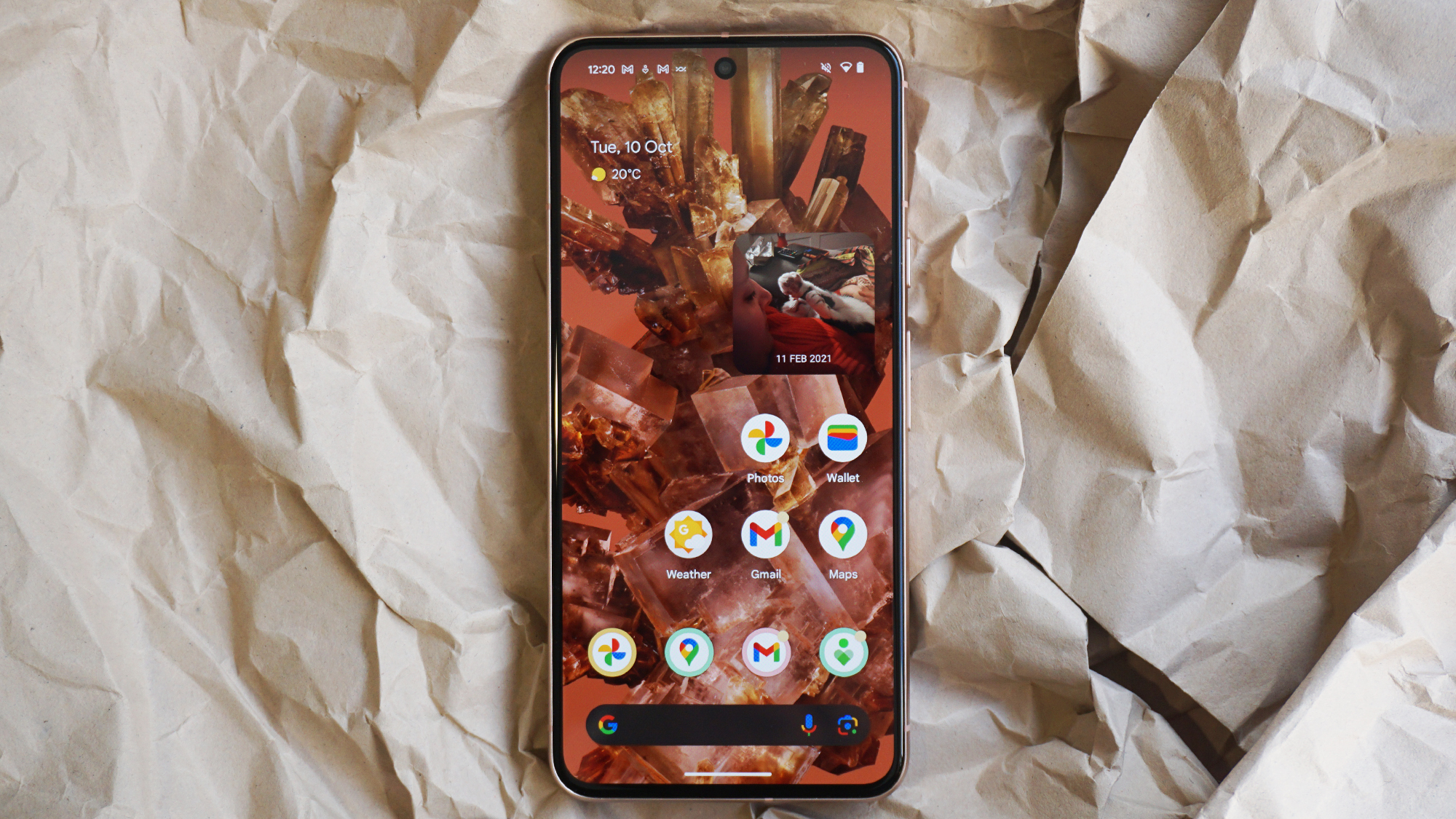
Both displays can hit a peak brightness of 2,000 nits, and both also max out at a 120Hz refresh rate. The latter is an interesting distinction, as the Apple phone that really competes with the Pixel 8 is the iPhone 15, which only manages 60Hz.
You could argue that the Pixel 8 screen carries a Pro-level refresh rate, though it should be pointed out that it’s not an LTPO panel. While the iPhone 15 Pro Max screen can drop all the way down to 1Hz, thus saving power, the Pixel 8 can only drop to 60Hz. This perhaps explains why the iPhone’s always-on display carries more visual detail.
The iPhone 15 Pro Max has the clear edge here in terms of fit and finish, as well as the sheer size and sophistication of its display. Of course, for the added price of a Google Pixel 7a, you’d expect as much.
Google Pixel 8 vs iPhone 15 Pro Max: cameras
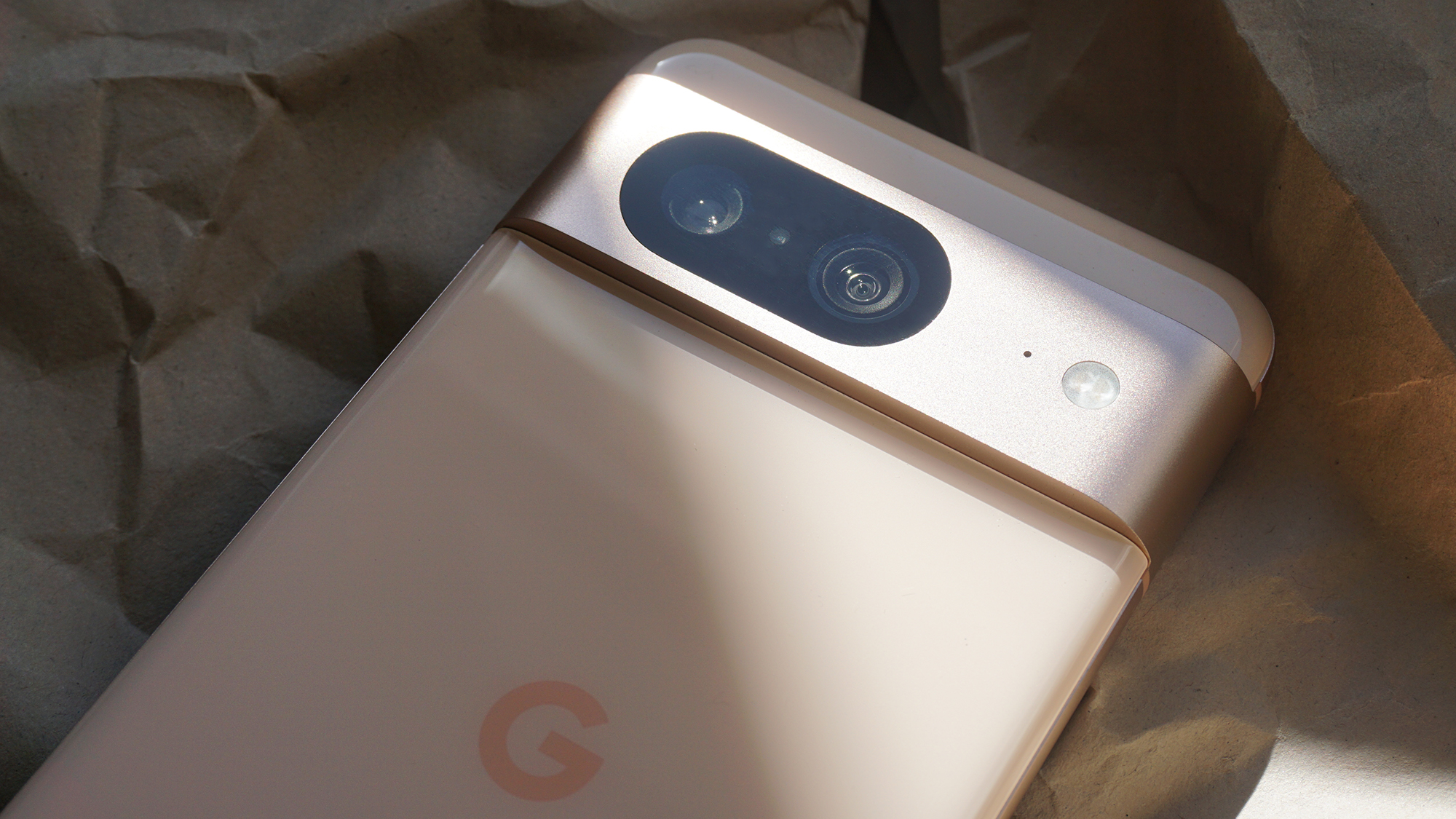
Apple shows its Pro credentials with a full three-camera set-up to the Pixel 8’s two. In addition to wide and ultra-wide sensors, the iPhone 15 Pro Max gives you a dedicated telephoto.
Not just any telephoto either, but a new 12MP periscope camera with an extended 5x zoom. The Pixel 8 can only crop in on its 50MP main sensor for those up-close shots.
Apple’s new 48MP 1/1.28“ main sensor is slightly larger than the Pixel 8’s 50MP 1/1.31” equivalent, and it also captures more detailed 24MP shots compared to the Pixel’s 12.5MP. The iPhone also backs this sensor with a superior sensor-shift OIS system, meaning it can stay steadier during those extended shutter time shots. Both phones give you high quality 12MP ultra-wide sensors.

iPhone 15 Pro Max camera samples





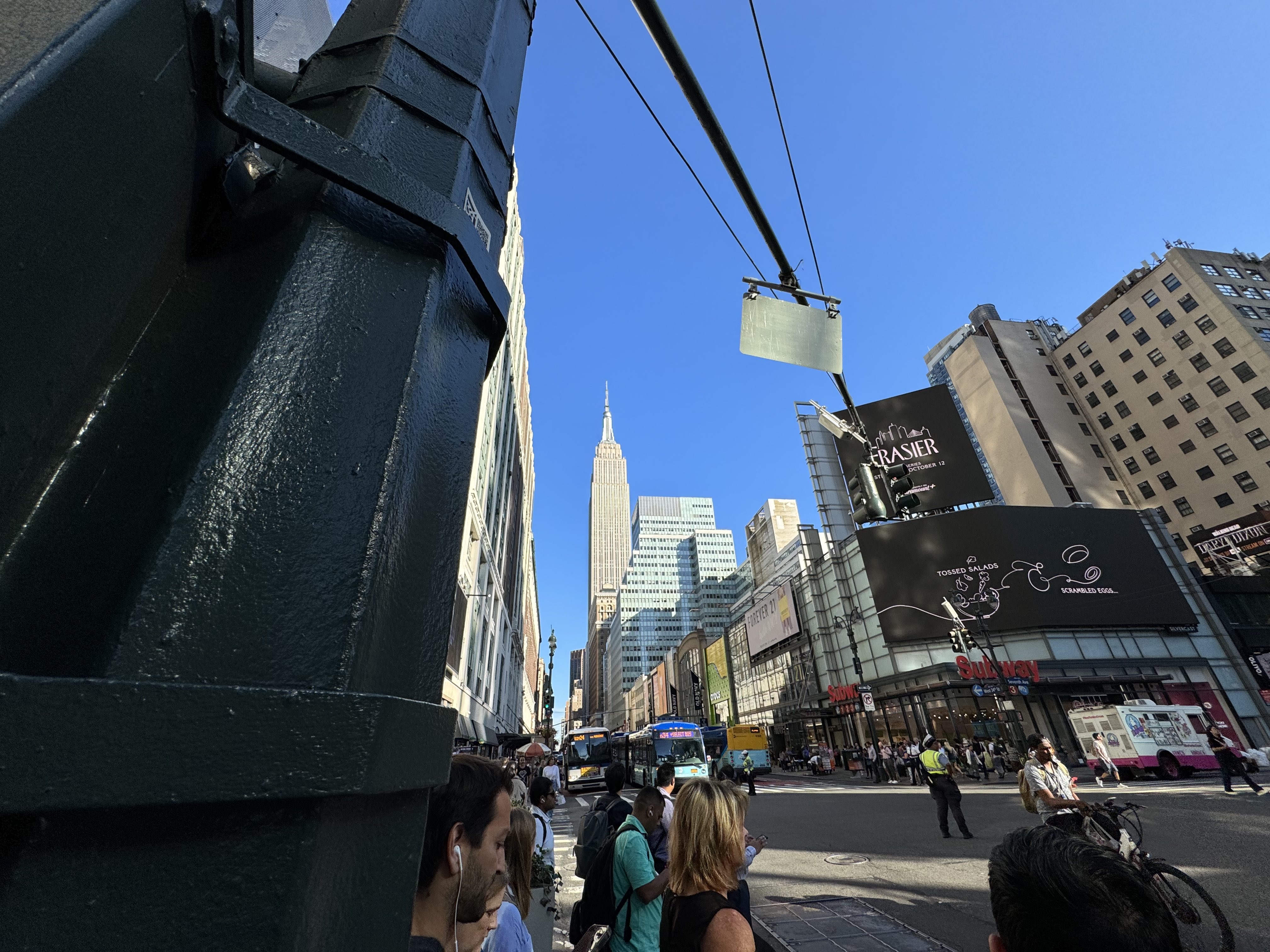
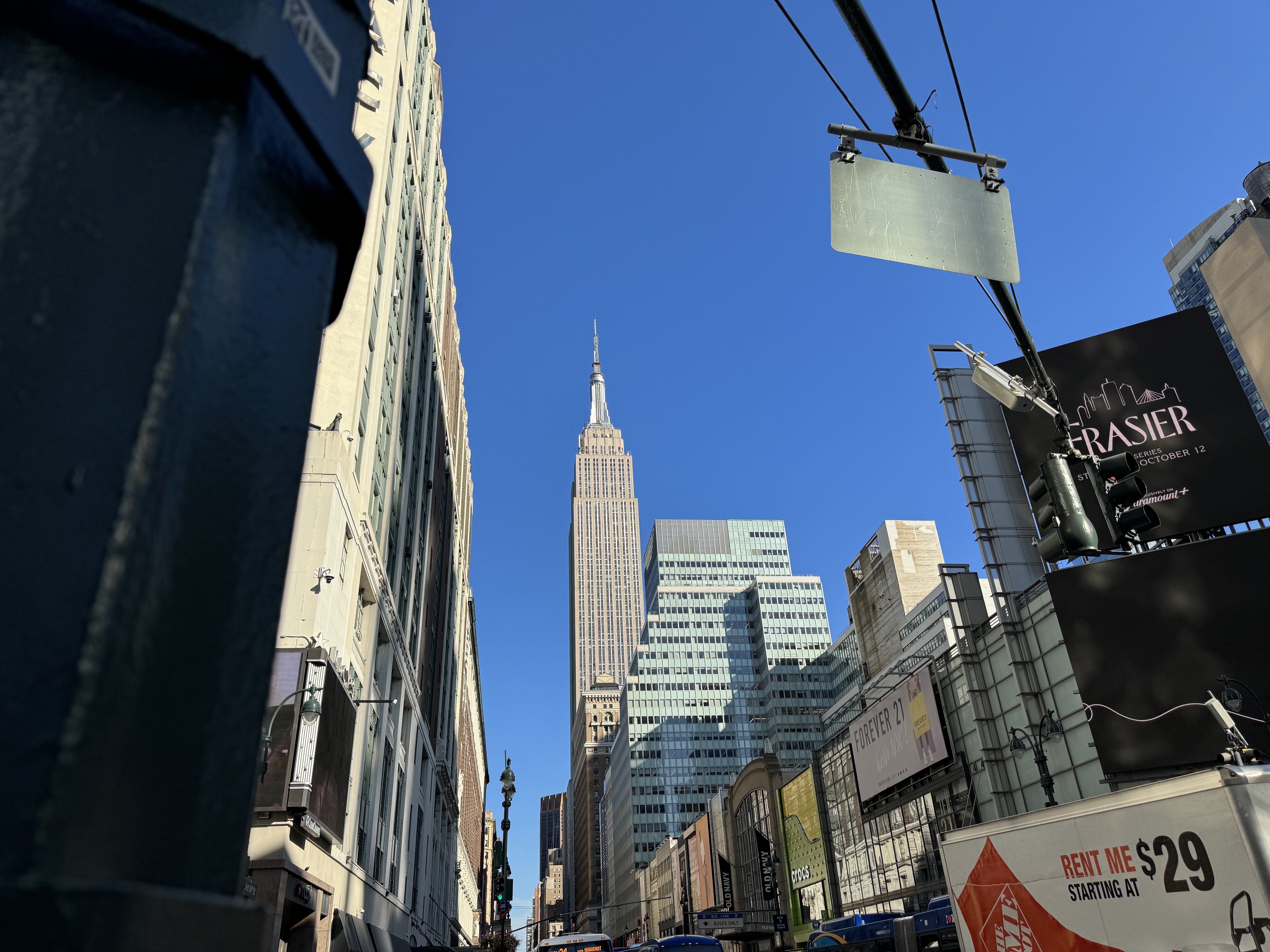



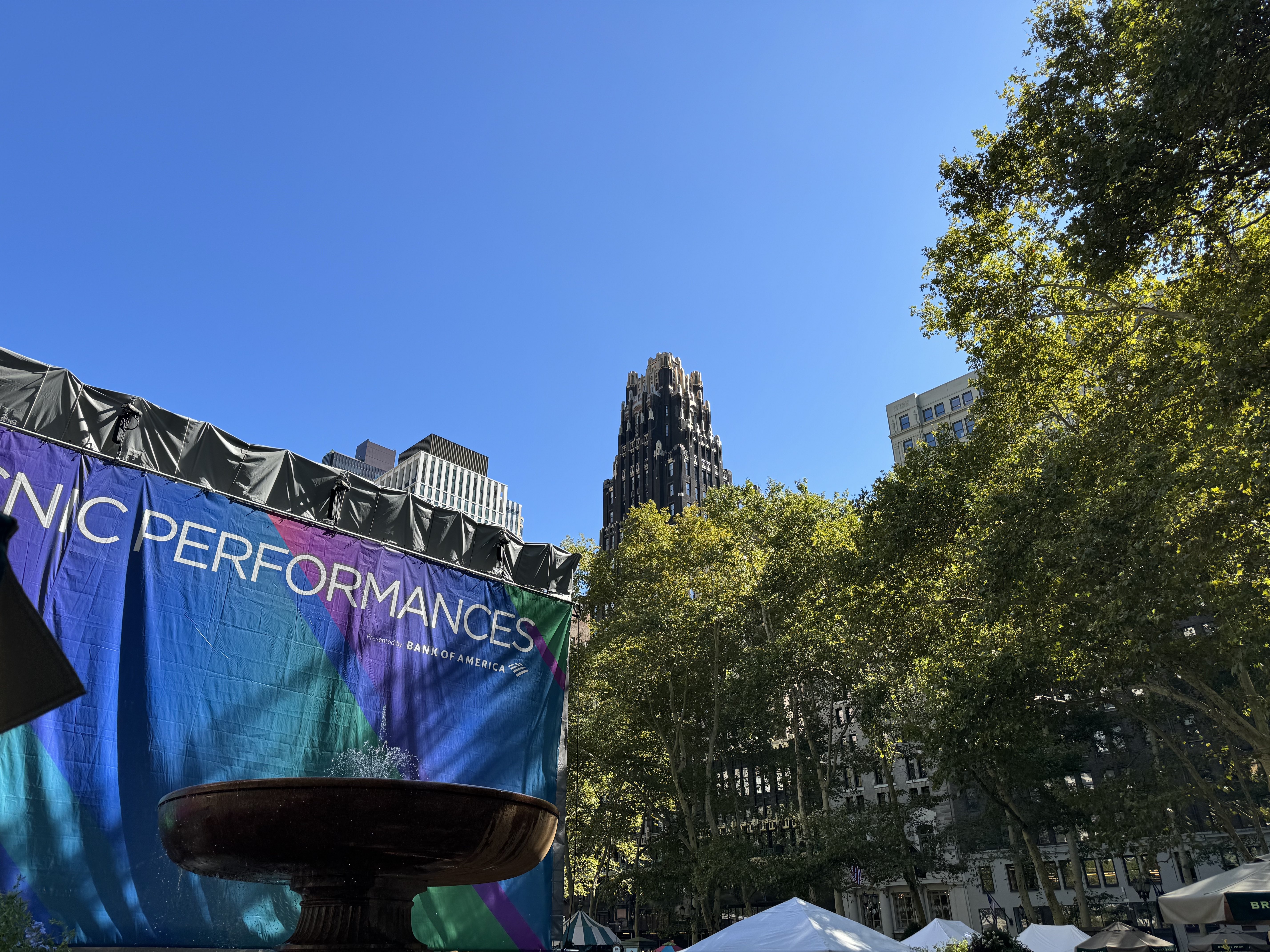
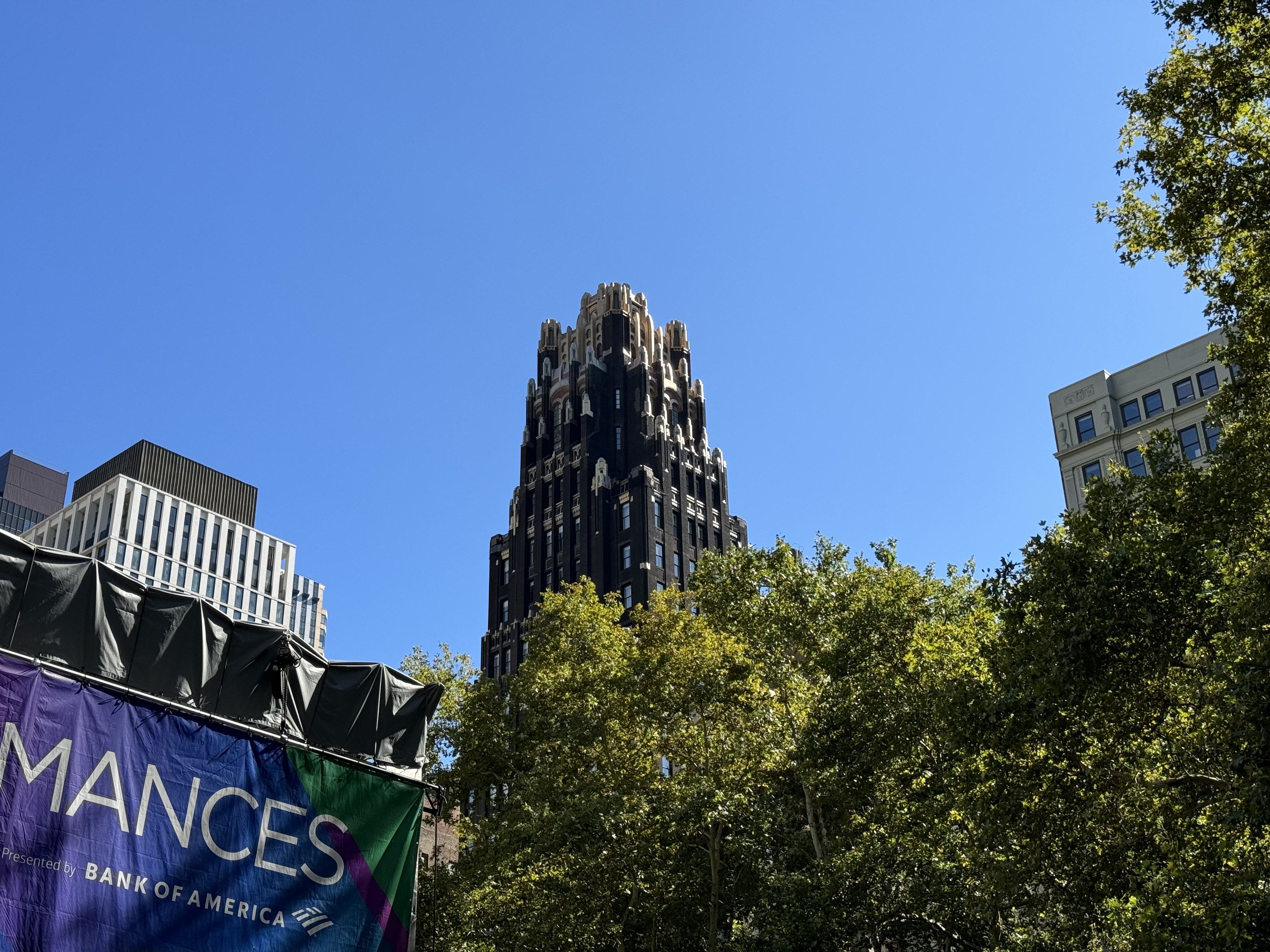








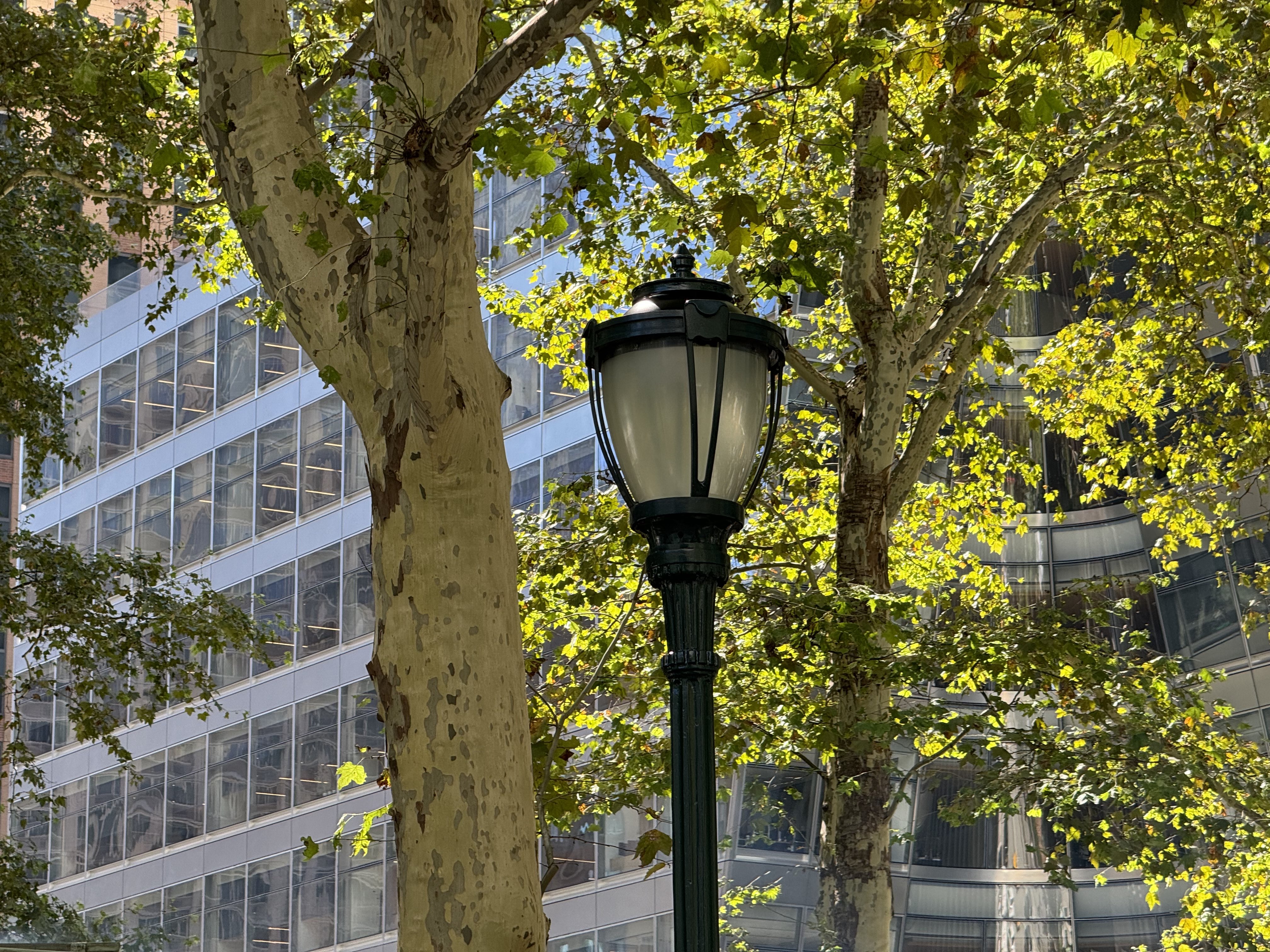

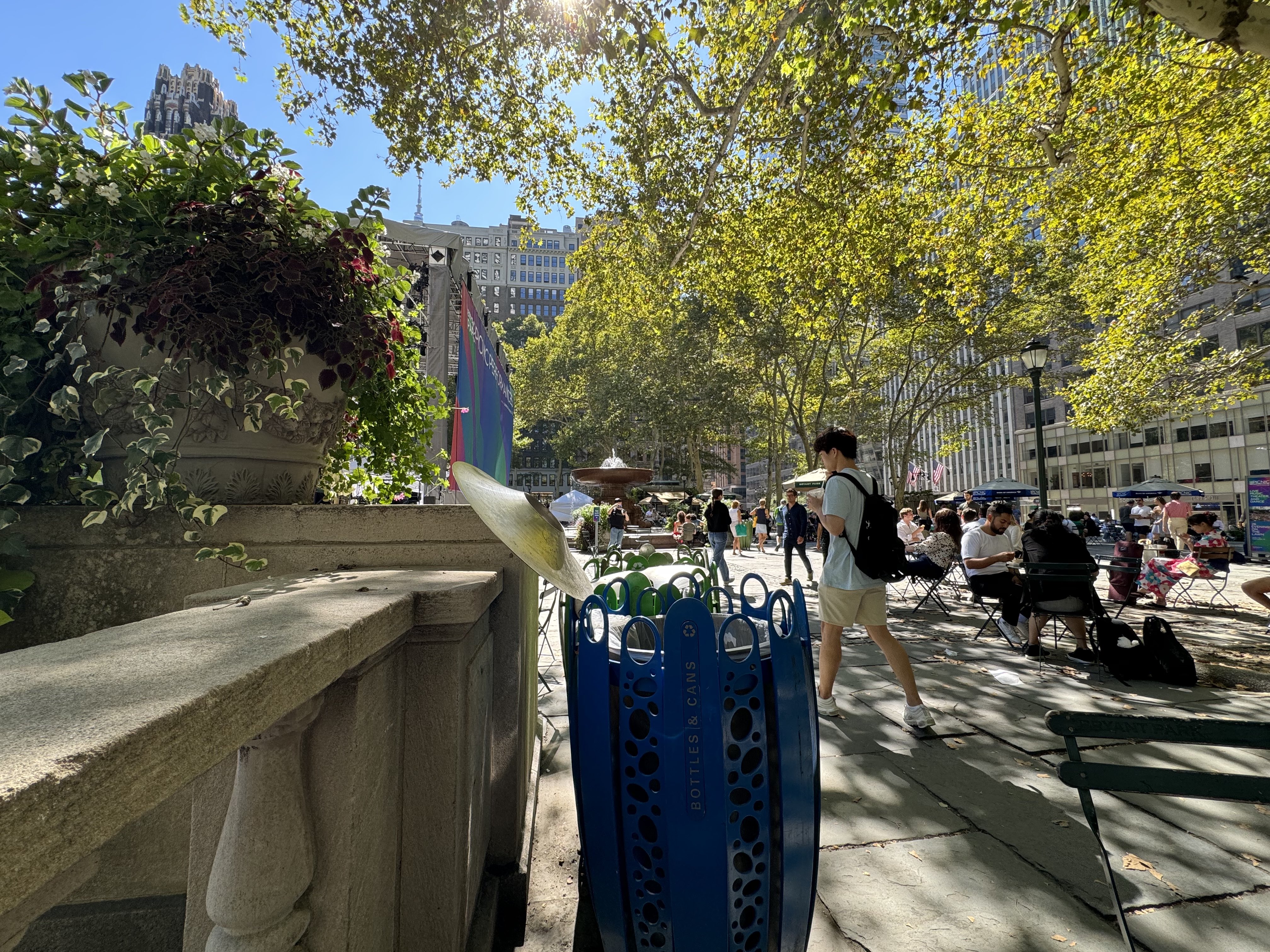
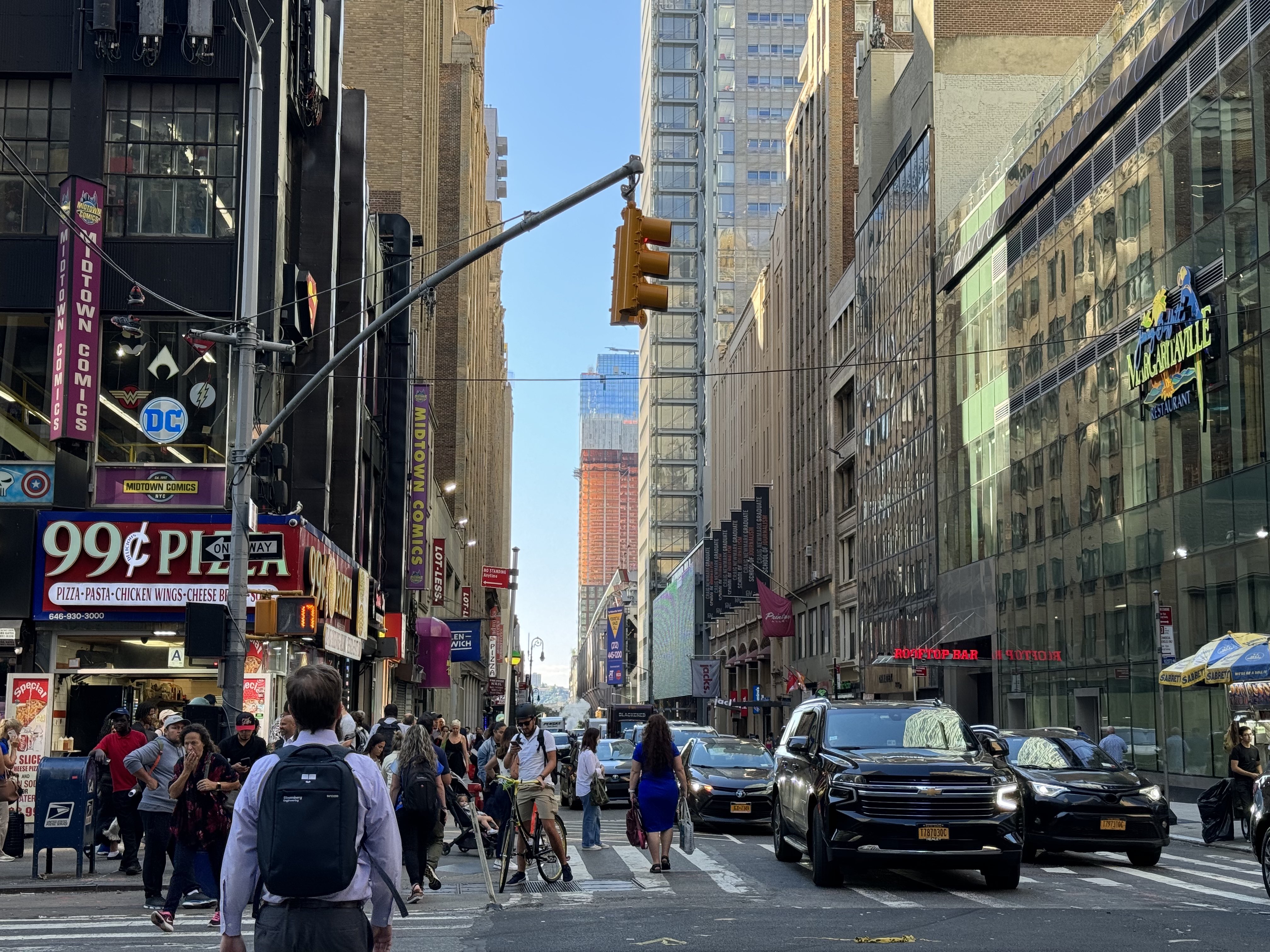









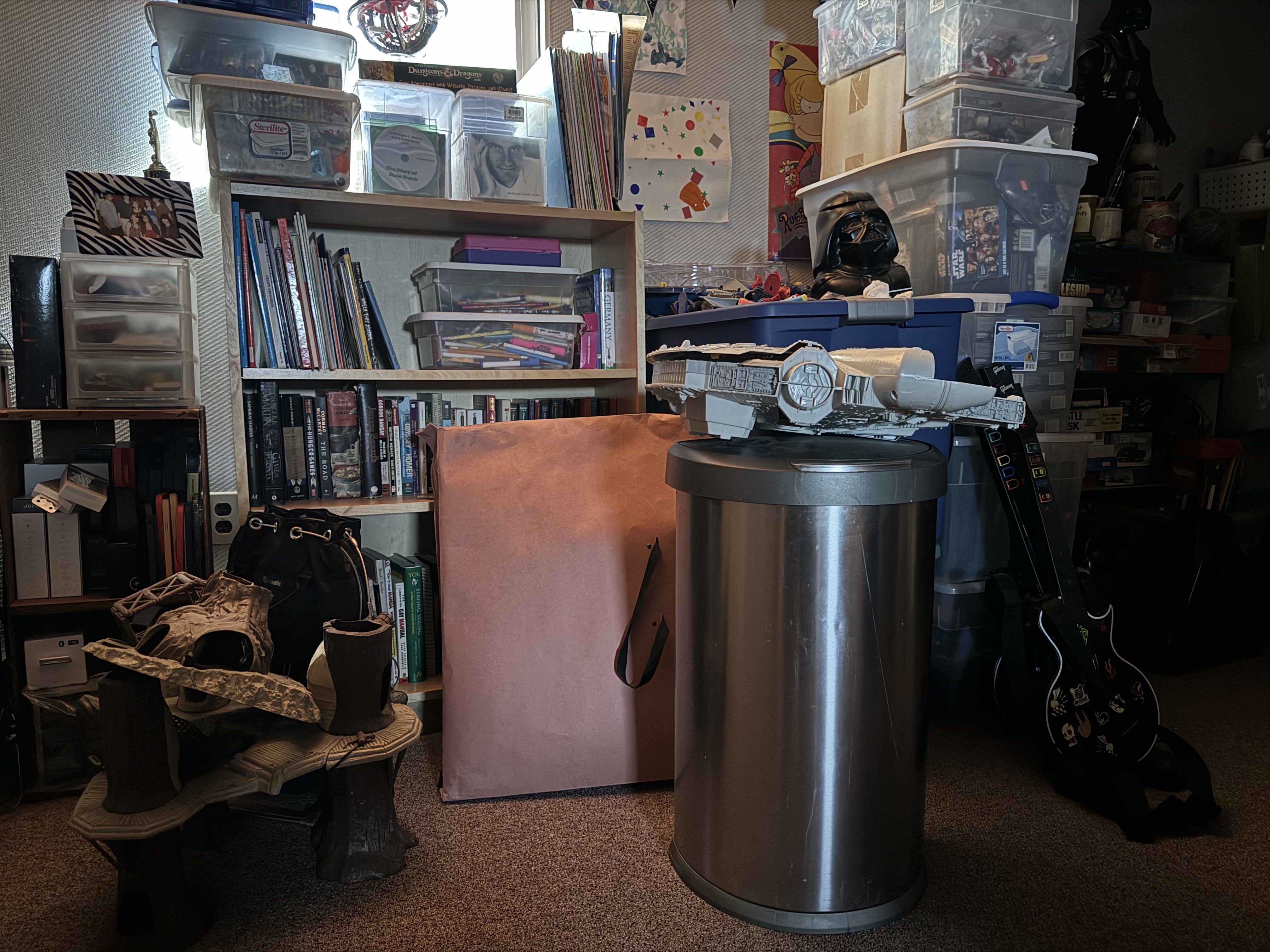


However, the main difference in overall photographic output from these two phones comes down to the choices and areas of expertise of the two manufacturers. Both devices take great shots, but Google’s color science is way cooler and more contrasty, while Apple’s is more naturalistic.
Google gives your some unique AI-driven editing tools here. Magic Eraser lets you remove unwanted background elements after the fact, while you can even insert a fake golden hour sky, with the color tone of the shot following suit. Best Take now lets you edit group scenes to make sure everyone is smiling.

Google Pixel 8 camera samples

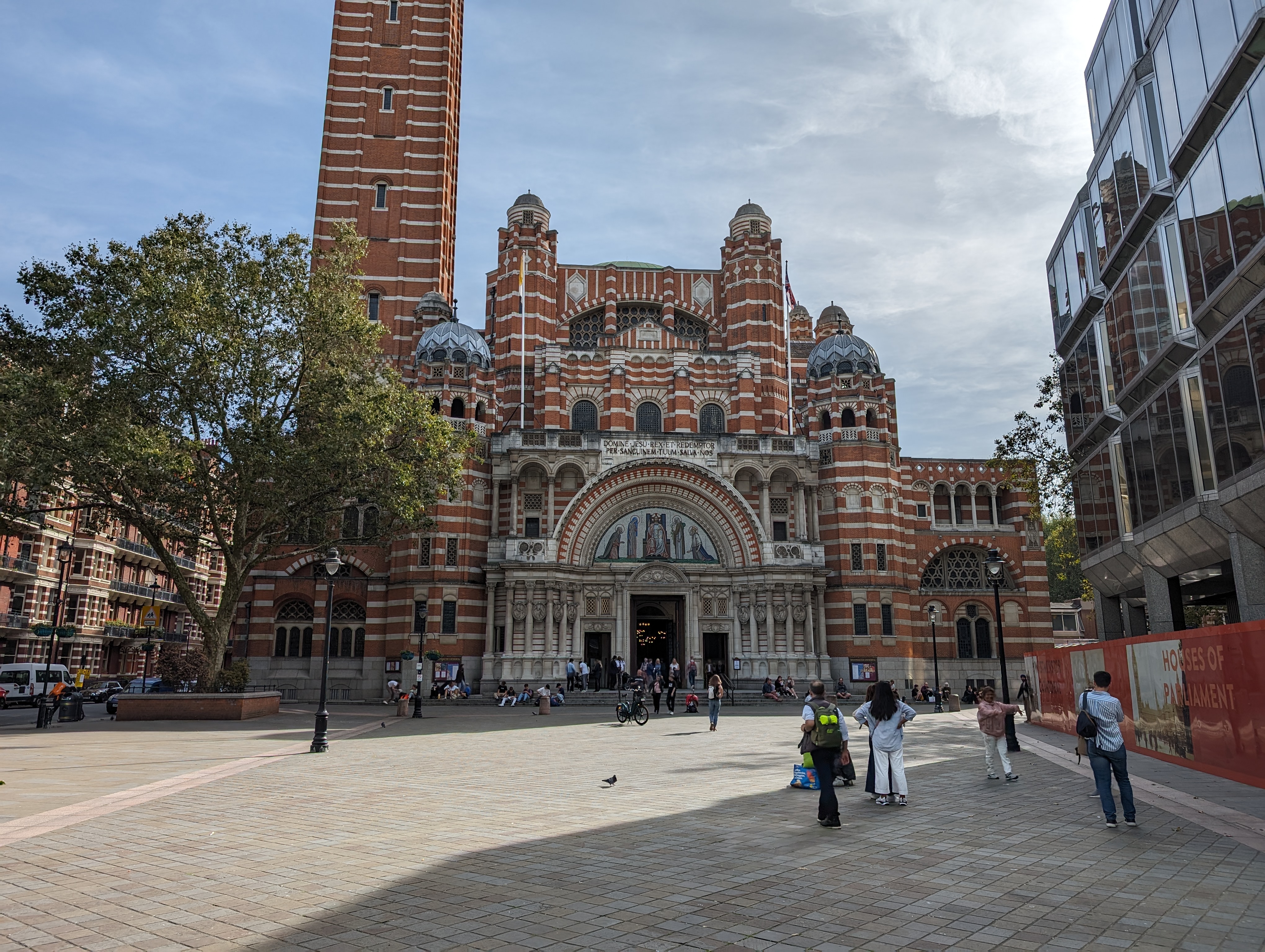



Ultra-wide

Main camera

2x zoom

8x zoom

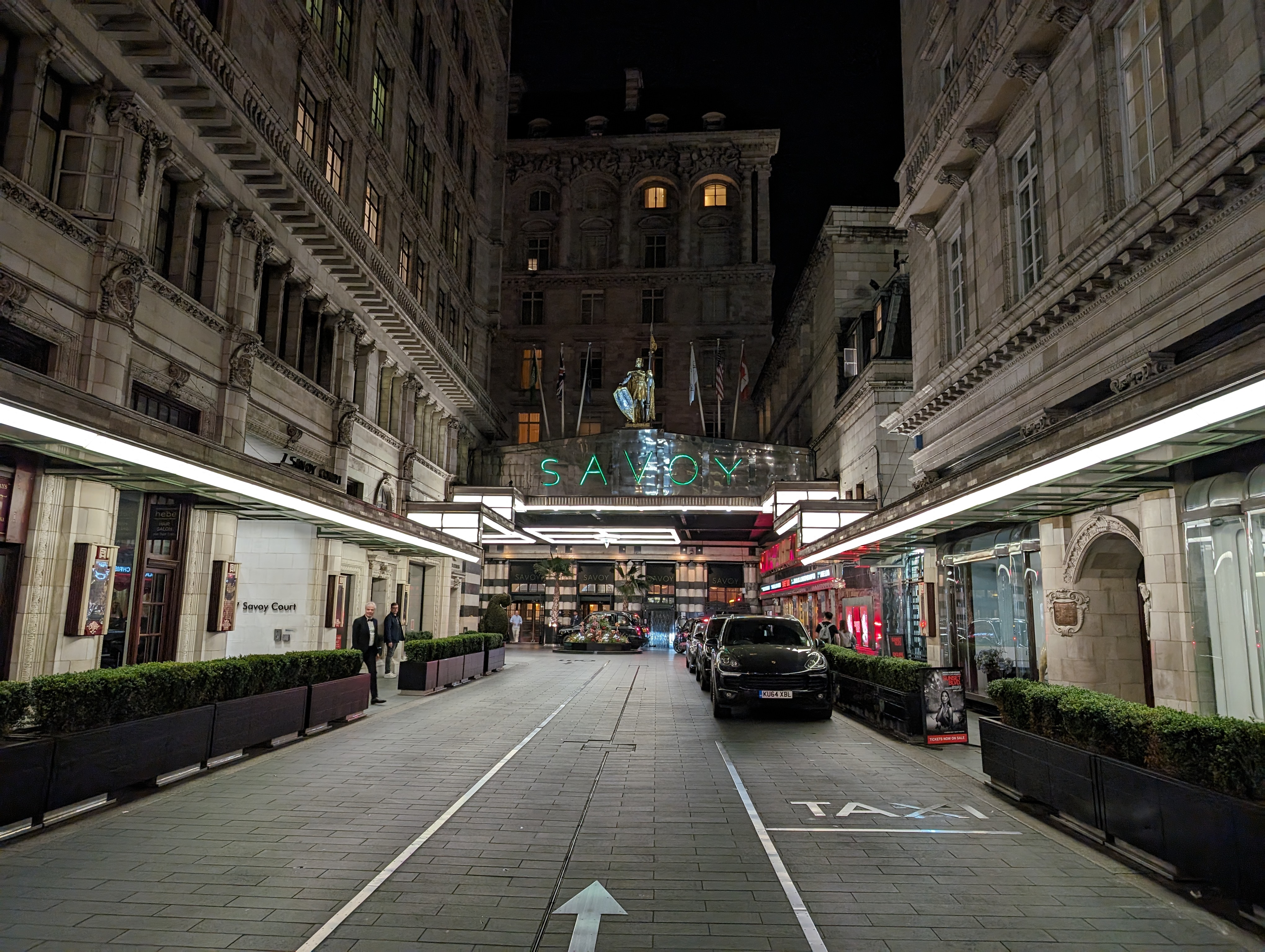
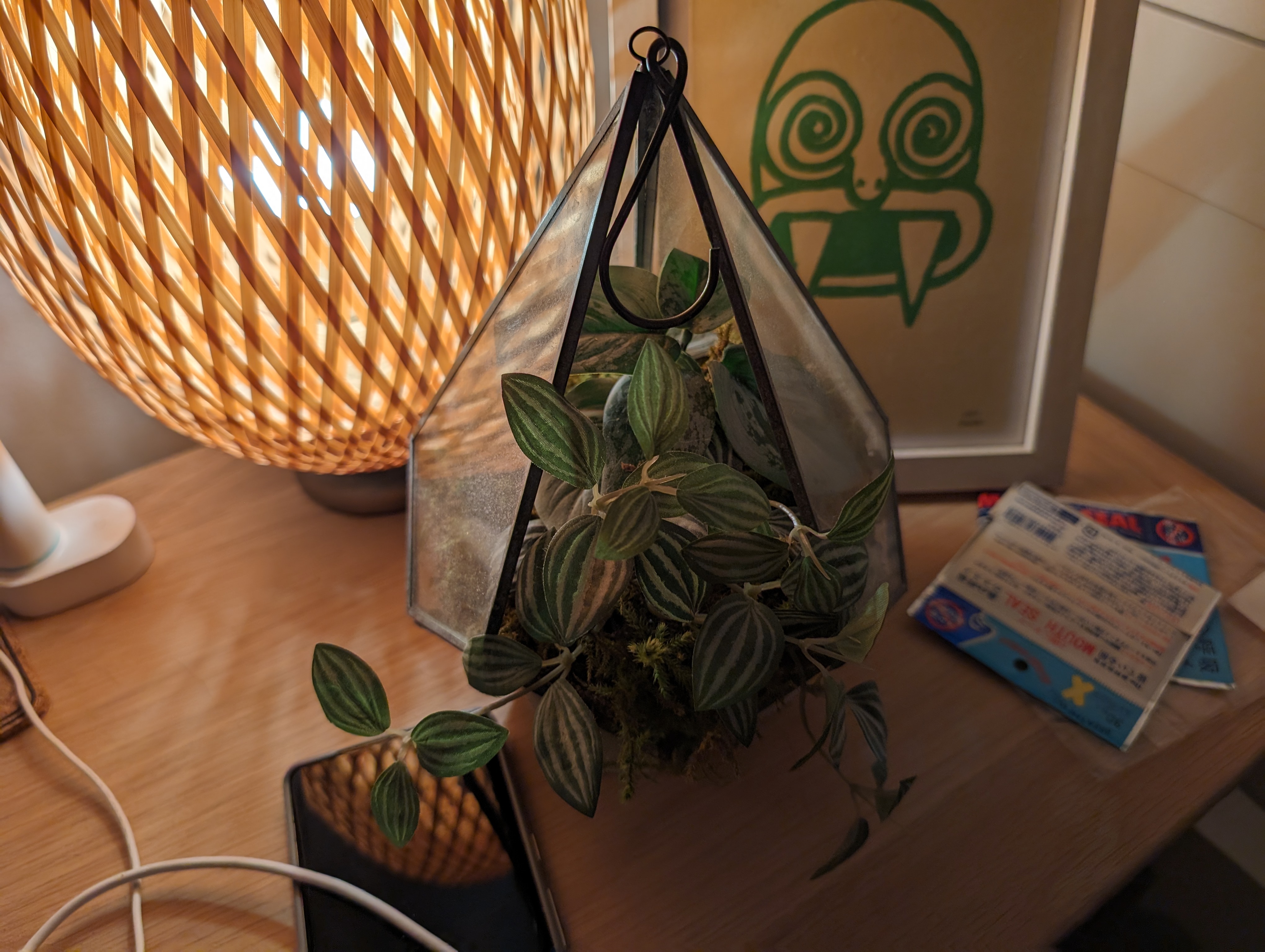

Portrait mode on main camera

Front camera

Portrait mode on front camera
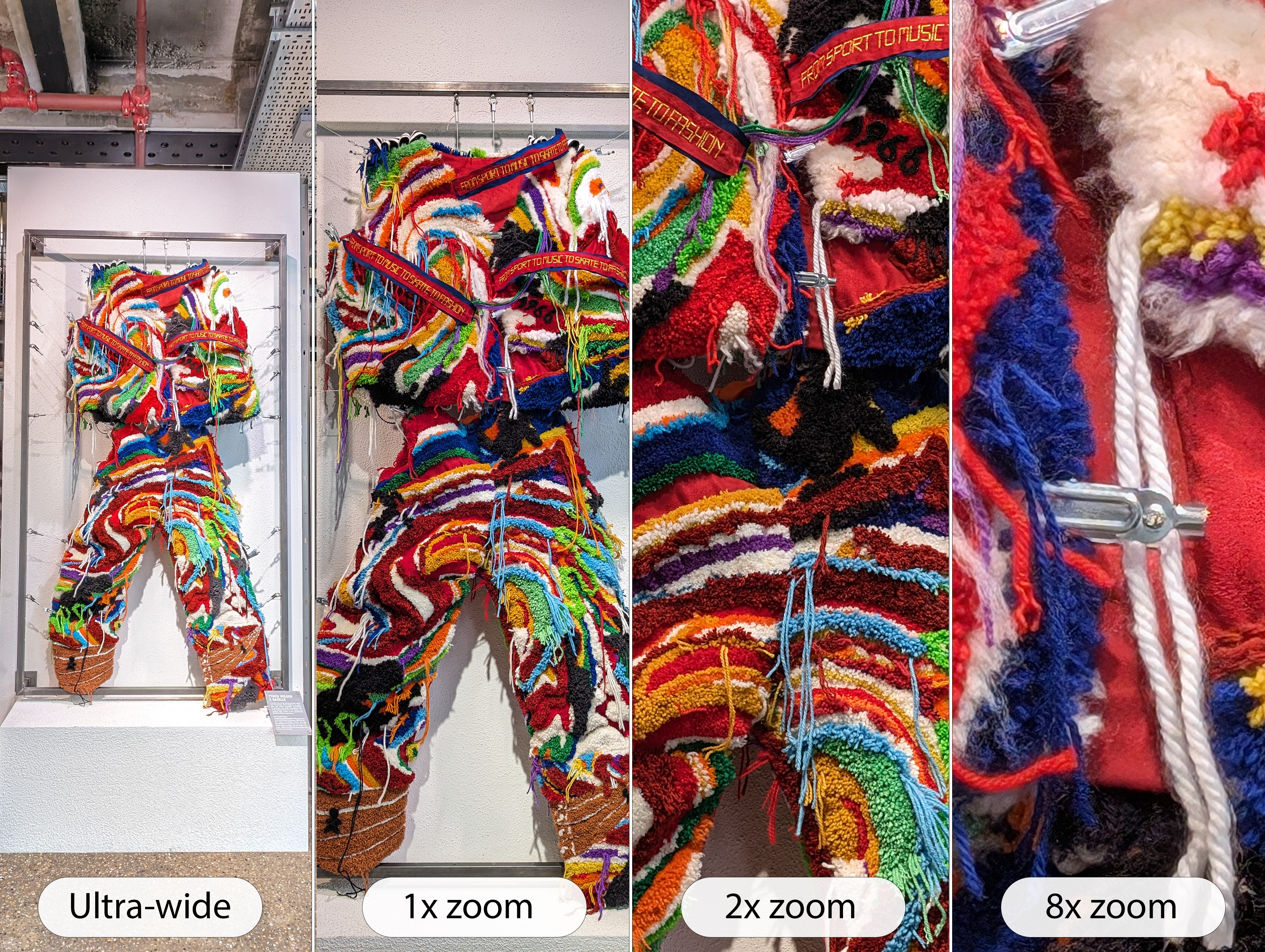
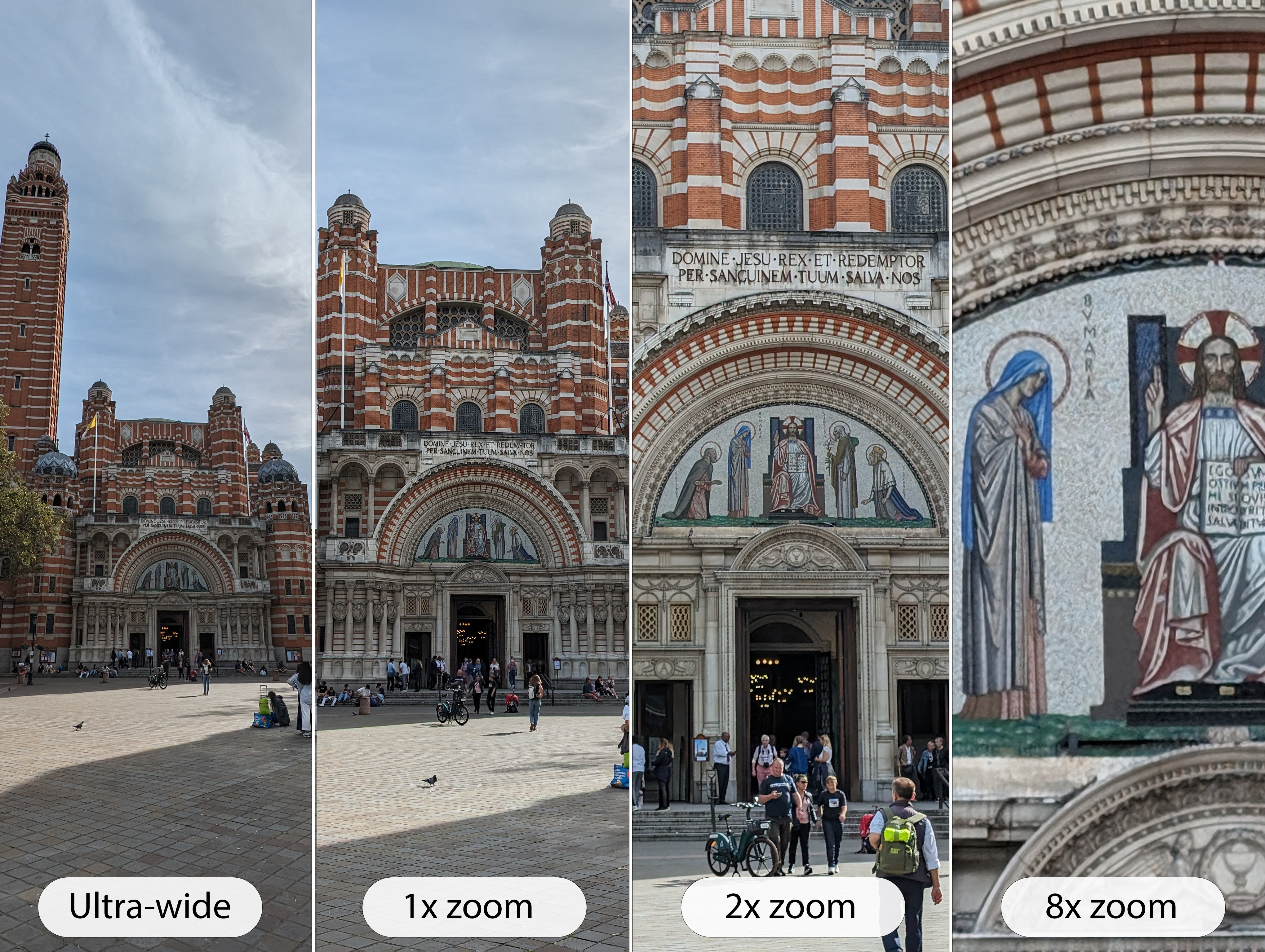
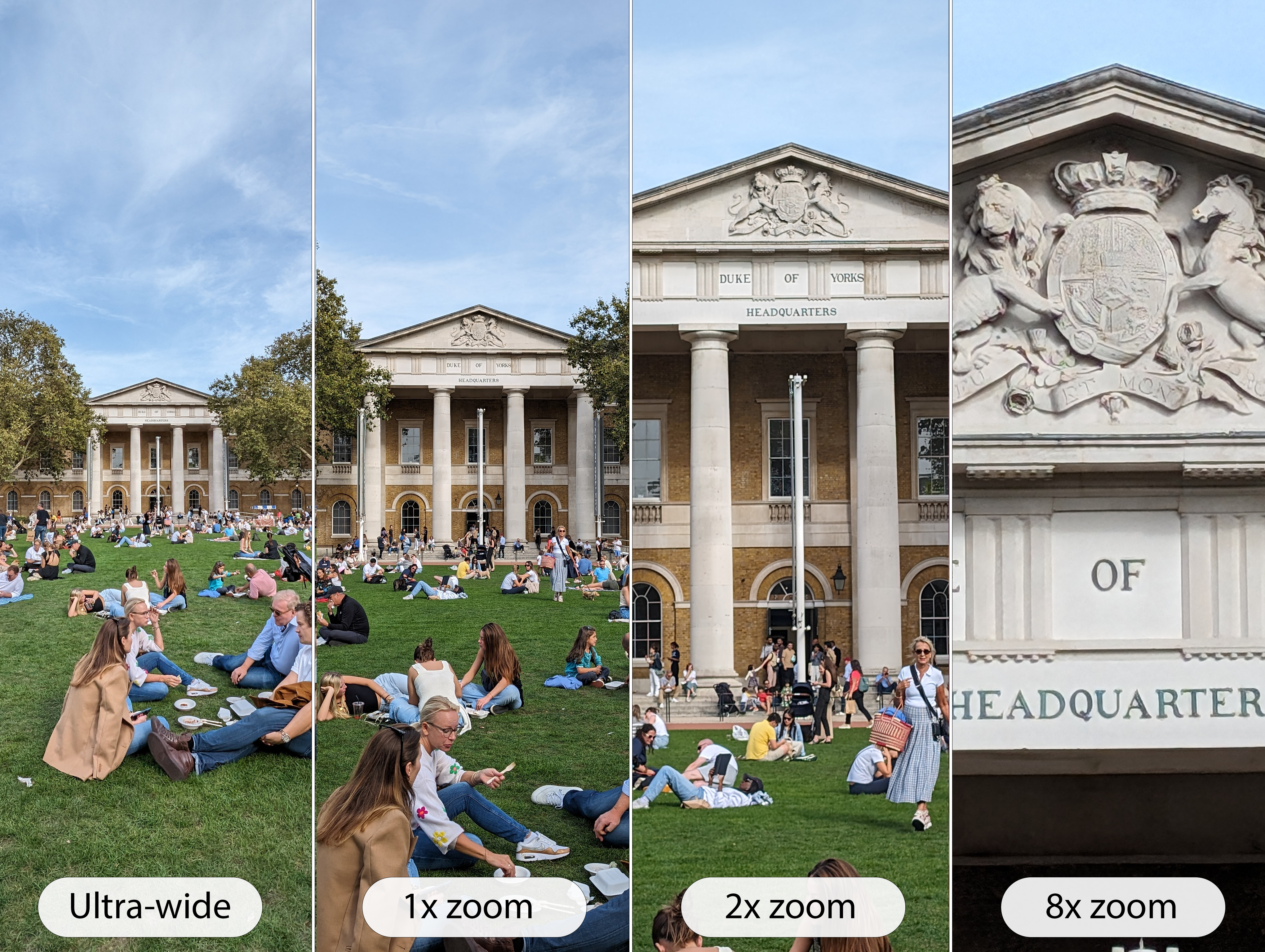

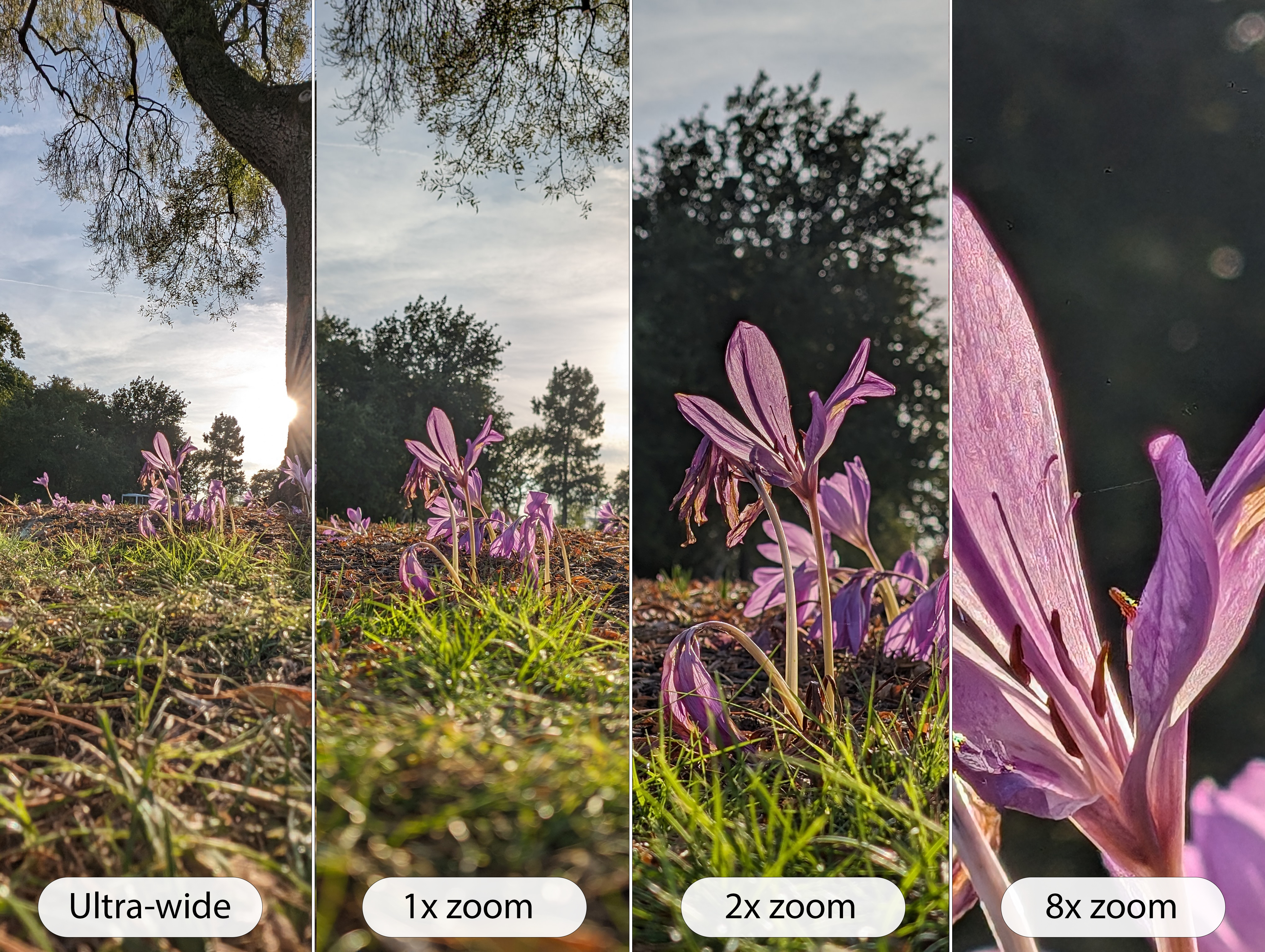
Overall, the iPhone 15 Pro Max is the more flexible camera system of the two, and a much better bet for anyone vaguely interested in core photographic principles. But the Pixel 8 uses clever processing tricks to provide a brilliant fire-and-forget experience.
Google Pixel 8 vs iPhone 15 Pro Max: performance and software
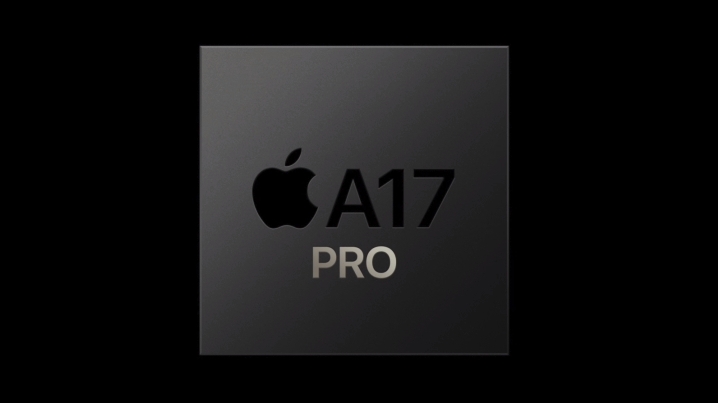
The iPhone 15 Pro Max has edged things so far, but it’s difficult to argue that ‘edging it’ is sufficient when there’s a $440 / £440 price difference.
There are no such worries for Apple when it comes to performance, where the iPhone 15 Pro Max mops the floor with its pint-sized rival.
Apple’s custom A17 Pro chip is so much faster than the Pixel 8’s custom Tensor G3 chip in classic CPU and GPU terms, they seem to be generations apart. Comparative benchmark scores do not make for pretty reading if you’re on the Google hardware team, that’s for sure.
In practical terms, you’re unlikely to notice this vast performance gap in general use, where both phones feel fast and fluid. There’s a chance you’ll spot the difference in more advanced tasks like high-end 3D gaming, but even there the Pixel 8 acquits itself well. We somehow doubt you’d be able to play Resident Evil Village smoothly on a Pixel 8, however, even if it wasn’t an iOS exclusive.
Perhaps more consequential is the matter of performance headroom. With both manufacturers supplying extended software support (seven years for Google, five or so with Apple), these are phones that are being built with the future in mind. Despite Google’s extended promise, however, we’re more confident that the iPhone will be running quickly in a few years time.
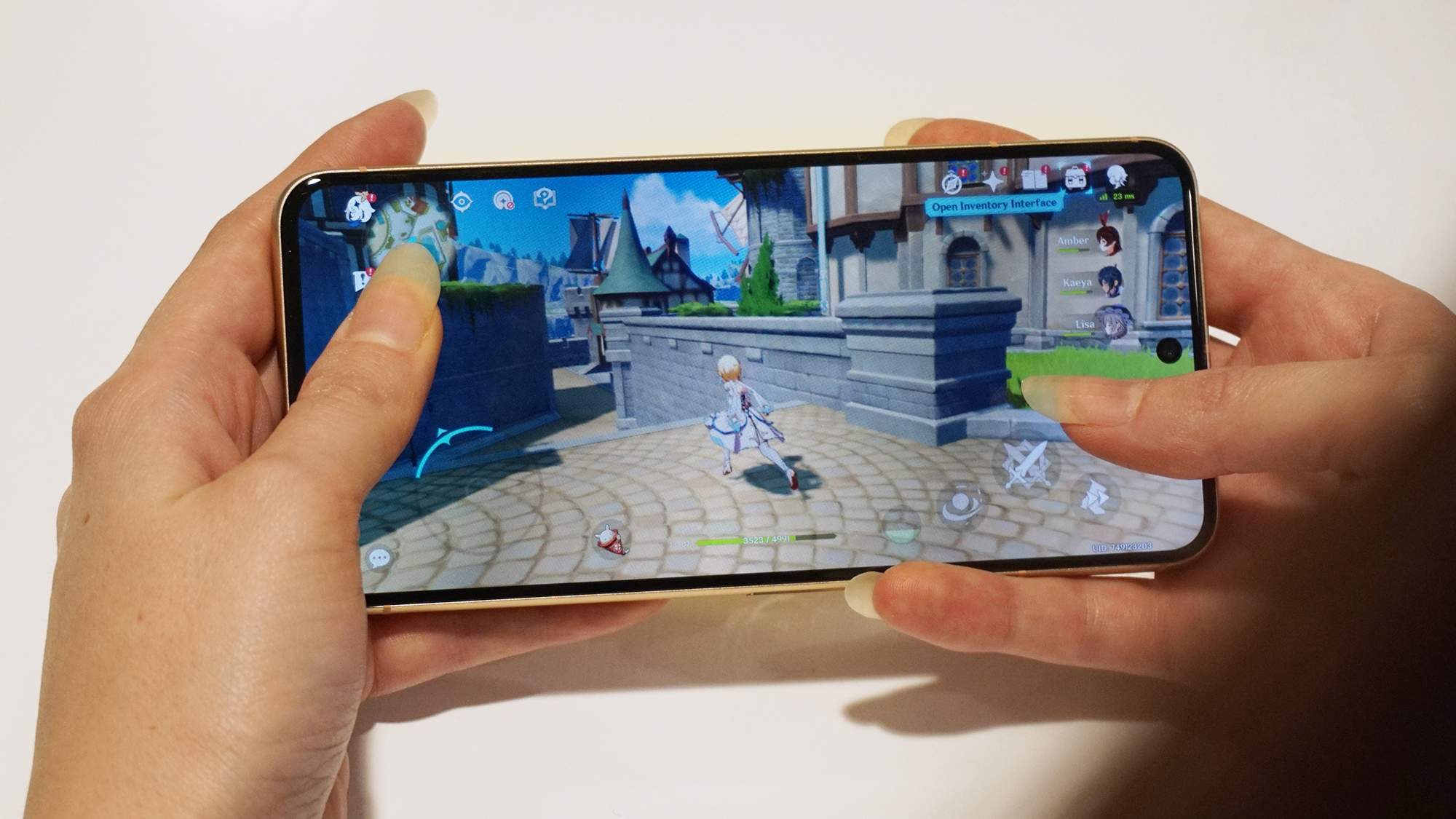
Google will claim that it doesn’t care about CPU and GPU performance so much as it does AI smarts, and on that front the Pixel 8 certainly pulls off some clever tricks. Real time video transcription, snappy voice typing, and the camera tricks we mentioned tricks mentioned above all rely (in part) on the Tensor G3’s machine learning capabilities.
We mentioned software above, and that really is the crucial difference between these two phones. Your decision over which to buy will likely come down to whether you’re already embedded in the Android or iOS ecosystem.
Have you invested time, money and data in apps and services for either platform? Do you own a Mac and an iPad, or an Android tablet and a Windows PC? You should answer those questions before considering any other aspect of these phones.
Otherwise, both Android and iOS are brilliant operating systems, and these phones showcase them at their best.
Google Pixel 8 vs iPhone 15 Pro Max: battery
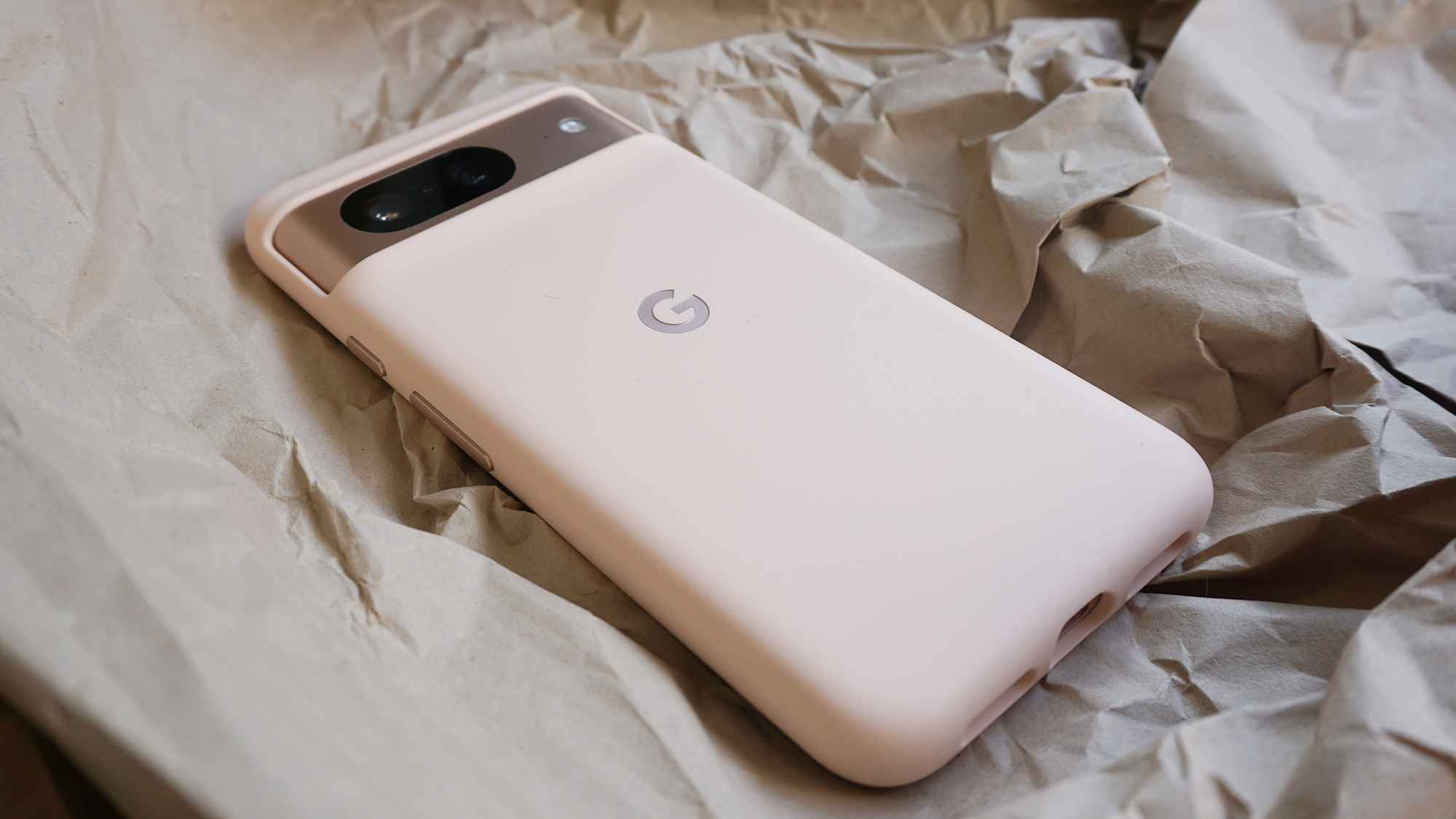
You’d think that the size disparity between these two phones would inform the capacity of their batteries, but that’s not really the case. While the Pixel 8 runs on a 4,575mAh cell, the iPhone 15 Pro Max only has a 4,441mAh cell.
Don’t let that similarity fool you though. Android is historically far more power-hungry than iOS.
Sure enough, the iPhone 15 Pro Max lasts quite a bit longer on a single charge, lasting the best part of two days of regular usage while the Pixel 8 is more of a one-dayer – albeit with some juice left at the end of that day.
When it comes time to charge up, both phones support up to 27W wired charging, though you don’t get a charging brick in either box. You can expect both to hit around 50% in 30 minutes.
The Pixel supports up to 18W wireless charging using the second-generation Pixel Stand, or the usual 12W with a generic Qi charger. The iPhone 15 Pro Max can support 15W wireless charging with a dedicated MagSafe charger, or 7.5W Qi charging.
Google Pixel 8 vs iPhone 15 Pro Max: verdict
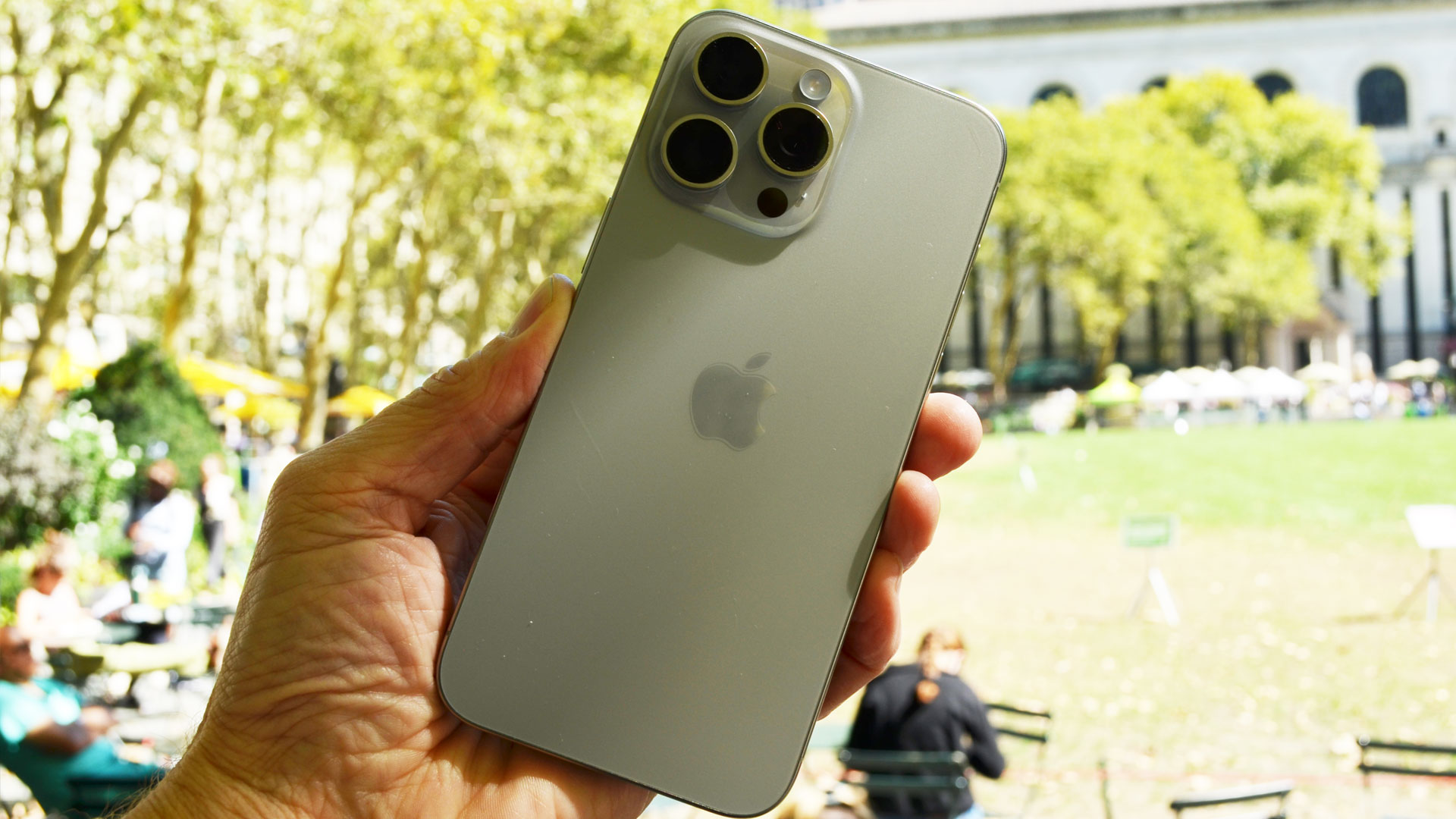
We feel confident in proclaiming that the iPhone 15 Pro Max is a better phone than the Google Pixel 8. It’s way more powerful, has a more premium design, a more flexible and capable camera, and superior battery life.
It’s not really a straight fight between these two phones, however. The Pixel 8 is significantly smaller and – crucially – $440 / £450 cheaper.
With those limitations in place, it’s remarkable what a competitive flagship experience Google has provided in the Pixel 8.
If money and pocket space are no object, and if you have no particular platform preference (or are already invested in iOS), then the iPhone 15 Pro Max is clearly the better pick here. Those ifs are doing some serious heavy lifting, however.
Get daily insight, inspiration and deals in your inbox
Sign up for breaking news, reviews, opinion, top tech deals, and more.